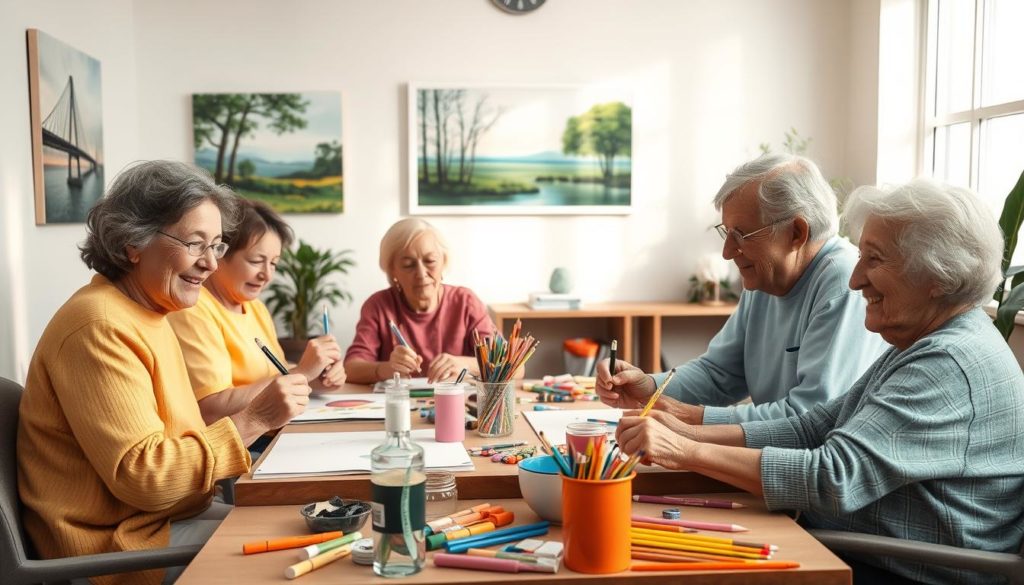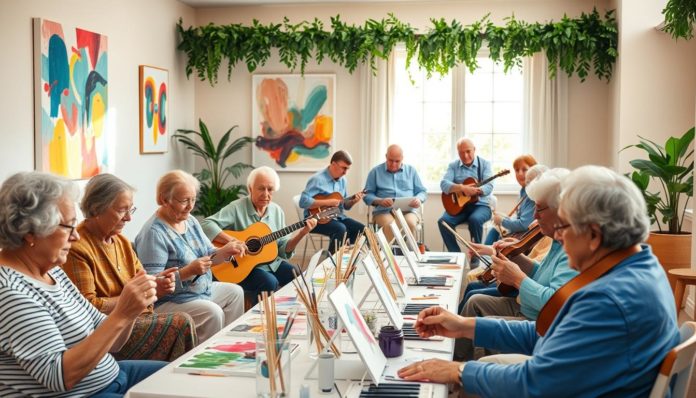Did you know 74% of Alzheimer’s patients improve in mood and awareness with art and music therapy? These methods do more than just engage; they greatly enhance life quality. They tap into memories and boost self-expression, offering hope in cognitive decline.
Activities like art and music are crucial for expression and engagement in Alzheimer’s care. Music therapy helps lessen agitation and behavioral issues. It keeps a strong connection to memories and improves mood.
Meanwhile, art therapy gives patients and caregivers a special way to connect through dementia art and music. It sparks creativity and gives a sense of achievement.
Introduction to Art and Music Therapy for Alzheimer’s
Art and music therapy are key in managing Alzheimer’s, focusing on personalized activities. These therapies provide non-medical ways to deal with symptoms, tailored to what each person enjoys. By doing activities linked to their hobbies, patients feel better and enjoy life more.
This kind of therapy helps keep dementia patients active and connected. It uses a custom approach, making sure everyone finds something they love. This makes their therapy times not only helpful but also fun.

Art and music therapy bring a more complete, human approach to Alzheimer’s care. They let patients find happiness, better moods, and a feeling of success through creativity. These therapies fill a crucial need, blending the right care with personal joy. They’re a full way to help with dementia.
Understanding the Benefits of Music Therapy for Alzheimer’s Patients
Music therapy helps Alzheimer’s patients in many ways. It touches their emotions, thoughts, and body wellness. Therapists use songs known to the patient to boost their overall well-being despite memory challenges.

Reduces Agitation and Behavioral Issues
Music therapy lowers stress and behavior problems in Alzheimer’s patients. Known songs bring calm and reduce anxiety. This makes patients act better and feel more at peace.
Stimulates Memories and Enhances Mood
Listening to beloved songs can bring back memories for Alzheimer’s patients. This sparks happy feelings, making them happier. Music connects them to their past, giving moments of happiness even in late stages of the condition.
Encourages Physical and Mental Activity
Music therapy boosts both movement and thinking in Alzheimer’s patients. Moving to the music or tapping along helps keep the body and brain active. This is crucial for their cognitive skills and overall health.
How Art Therapy Can Enhance Quality of Life for Dementia Patients
Art therapy offers a unique way for those with dementia to share their feelings. When it’s hard to speak, creating art lets them express themselves freely. This promotes their emotional health, uplifting their spirit.
Promotes Self-Expression and Creativity
Creative arts like painting and drawing open new doors for communication. They help seniors bring hidden memories to the surface. More than just hobbies, these activities allow for storytelling that goes beyond words.
Improves Emotional Well-Being
Seeing and sharing their artwork boosts patients’ self-esteem. Art therapy techniques for seniors with dementia lessen loneliness and worry. This brings a happier mood and improves how they interact with others.
Adding creative arts into daily care gives meaningful support to those with dementia. It deeply enriches their lives, bringing joy and comfort.
Effective Art Therapy Techniques for Seniors with Dementia
Art therapy brings great benefits for Alzheimer’s patients. It helps them discover creative ways to improve their life. These methods support seniors in expressing themselves artistically.
Painting and Drawing
Painting and drawing allow seniors with dementia to express themselves. These activities boost their brain activity. Making sure to use safe, adult-level materials makes this a secure way for seniors to unleash their creativity.
Sculpting and Clay Modeling
Sculpting and clay work are engaging activities for those with Alzheimer’s. They get to feel different textures and make something with their hands. This not only helps with their motor skills but also gives them a proud sense of achievement.
Collage Making
Creating collages is an easy art therapy approach for seniors. It lets them share their feelings and memories in a visual way. Working with different textures and pieces, they can put together art that has deep meaning, helping both their emotional well-being and mental focus.
Using Music to Connect with Alzheimer’s Patients
Making a connection through music therapy is a powerful way to connect with Alzheimer’s patients. This happens as talking gets harder for them. Music therapy for Alzheimer’s uses melodies to bring back memories and feelings hidden by the disease.
Choosing songs related to the patient’s life helps caregivers connect on a deeper level. Watching how patients respond to different songs gives hints on what they enjoy. This makes each music session more personal and effective.
Here are some tips to enhance the connection:
- Observe Responses: Watch for any mood or behavior changes with different songs.
- Create Playlists: Make playlists with songs that are special to the patient.
- Engage Interaction: Promote clapping, singing, and simple movements to deepen the connection.
- Consistency Matters: Use music regularly in daily routines to offer comfort.
The main aim of music therapy for Alzheimer’s is to create meaningful connections in a caring way.
Therapeutic Art Activities for Alzheimer’s Residents
Art therapy is key for Alzheimer’s patients. It boosts their creativity and emotional health. We must pick activities that match their abilities and disease stages. Keeping activities adult-level prevents them from feeling less valued, boosting their self-worth.
We must choose safe materials for these art therapies. They should allow for chatting and remembering the past. Using items like family photos helps spark conversations. Making collages, shaping clay, and painting are good. They calm and refresh the brain.
- Collage Making: Patients cut and paste to make unique pictures. This helps them share memories in a visual way.
- Clay Sculpting: Working with clay improves hand skills and is calming.
- Watercolor Painting: This lets patients paint freely, offering a peaceful experience. Good for any Alzheimer’s stage.
Below is a table comparing these art activities:
| Activity | Benefits | Materials |
|---|---|---|
| Collage Making | Boosts creativity, helps recall memories | Magazines, scissors, glue, poster boards |
| Clay Sculpting | Better hand skills, soothing touch experience | Non-toxic clay, sculpting tools |
| Watercolor Painting | Promotes self-expression, induces peace | Watercolor paints, brushes, paper |
Creating a Calming Environment with Music Therapy
Music therapy has shown huge benefits for those with Alzheimer’s. A carefully designed music therapy environment can lessen unrest and boost well-being. Here’s how to craft the ideal atmosphere with Alzheimer’s calming techniques.
Choosing the Right Music
Picking the right music means focusing on the individual’s likes and past. Songs they recognize can bring back happy memories and feelings. Try including different types of music like classical, jazz, or oldies to create a peaceful and happy environment.
Maintaining an Ideal Volume
In music therapy environments, getting the volume right is key. It’s crucial that the music isn’t too loud or too soft. Adjust the volume after seeing how the person reacts. This helps avoid any discomfort or miss listening to the music.
Combining Music with Movement
Adding movement to music brings an active element to therapy. Engage in simple movements such as swaying, clapping, or tapping along. These activities boost physical activity and create a connection, bringing happiness.
Art Programs for Alzheimer’s Patients: Success Stories
Art programs for Alzheimer’s patients have led to great success. They boost mood, engage the mind, and improve well-being greatly. Caring Hands Assisted Living has been a key player. Here, art activities have helped with emotional and mental health.
A former painter, now a resident, found happiness again by joining these activities. This shows art support can bring back passion and creativity for Alzheimer’s patients. At Memories in the Making, watercolor painting helps with memory and expression. It eases depression and anxiety, too.
Furthermore, these art programs boost social interaction. They build a community feeling and shared experiences among residents. At Brushes and Smiles, displaying their art allows for appreciation and encouragement from others.
Incorporating Art and Music into Daily Alzheimer’s Care
Bringing art and music into daily care can make life better for Alzheimer’s patients. It helps when these activities happen regularly. Through art and music, patients find new ways to share and express themselves.
Scheduling and Consistency
It’s crucial to have a set time for art and music. This helps patients get used to and enjoy these activities. Caregivers should plan for painting, drawing, or enjoying music at the same time each day.
Using Art and Music to Foster Communication
Art and music are great for helping Alzheimer’s patients talk more. These activities let patients share their feelings without needing words. For example, painting and music can bring back memories and help share emotions they can’t say out loud.
Resources and Support for Implementing Art and Music Therapy
Setting up art and music therapy for Alzheimer’s patients needs various resources and strong support. This includes online help like ALZNavigator and tips from doctors who know about these therapies. Knowing what’s available and matching it to each patient’s needs makes the therapy work better.
To make sure it works, caregivers can use resources like ALZNavigator for step-by-step advice. For example, ALZNavigator helps find resources and make a care plan that fits. The Alzheimer’s Association also shares how to pick the best music and art activities. These activities help Alzheimer’s patients feel more involved and happy.
- Online Tools: Use ALZNavigator to find Alzheimer’s therapy resources and tailor care plans.
- Healthcare Professional Recommendations: Get advice from experts on personalized therapy options for each patient.
- Environment Creation: Learn to create a peaceful and supportive space with adult art and familiar tunes.
Choosing the right activities for art and music therapy is crucial. It’s about knowing what the patient likes and offering familiar tunes and adult-level art that they enjoy. This gives them a sense of achievement and purpose.
| Resource | Description | Benefits |
|---|---|---|
| ALZNavigator | An online tool offering personalized caregiving plans. | Customized plans, easy navigation, comprehensive support. |
| Healthcare Professionals | Expert recommendations tailored to individual needs. | Personalized therapy selection, professional advice. |
| Art and Music Therapy Guidelines | Guidelines from the Alzheimer’s Association on effective therapy. | Increased engagement, improved well-being, reduced agitation. |
Using these therapies with proper support can improve communication, create a soothing space, and better the lives of those with Alzheimer’s. Having access to Alzheimer’s therapy resources helps caregivers give the best care to their loved ones.
Future Directions in Art and Music Therapy for Alzheimer’s Care
The use of art and music therapy for Alzheimer’s patients is showing great promise. We are now looking towards the future, aiming to make these therapies even better. A big step forward is making the therapy more personal for each patient. This means the care given fits what the patient likes and needs. Therapy that feels right for the person can really help them feel more involved and see better results.
Also, there’s a lot of exciting work being done to bring new technologies into art and music therapy. Things like virtual reality (VR) and augmented reality (AR) are starting to be used. These tools can make therapy sessions more engaging. They help patients dive into art and music in new ways, which can boost their mood and brain function.
Another cool development is the move towards offering art and music therapy online. This is great news for patients who can’t leave their homes or live far from therapy centers. By combining traditional therapy methods with the latest tech, we can reach more patients. This push towards innovation will not only make therapy better today. It will also encourage more research and improvements for treating Alzheimer’s in the future.
FAQ
What are the primary benefits of art and music therapy for Alzheimer’s patients?
Art and music therapy help with expression and reduce stress. They boost mood and offer mental and physical activity for Alzheimer’s patients.
How do art and music therapies differ in their approach to Alzheimer’s care?
Music therapy uses known songs to bring back memories. This helps connect emotionally and calm behaviors.
Art therapy lets patients be creative through various art forms. This boosts emotional health and gives a feeling of achievement.
What types of music are most effective in music therapy for Alzheimer’s patients?
Songs linked to positive memories from the past work best. The music should be clear and at a good volume.
What are some recommended art activities for Alzheimer’s patients?
Activities like painting, drawing, sculpting, and making collages are great. They let seniors with dementia express themselves in many ways.
How can caregivers create a calming environment for music therapy?
Caregivers should pick soothing music, control the volume, and reduce background noise. Adding simple actions like clapping or dancing is good too.
What are some success stories of art programs for Alzheimer’s patients?
Success stories often talk about better mood and mental activity. They show art activities having a positive effect on Alzheimer’s patients.
How can art and music be integrated into the daily care of Alzheimer’s patients?
Having a set time for art and music activities helps a lot. It improves communication and life quality for the patients.
Where can caregivers find resources and support for implementing art and music therapy?
Resources like ALZNavigator, tips from health pros, and online tools are helpful. It’s key to choose methods that fit the patient’s needs and likes.
What advancements are being made in art and music therapy for Alzheimer’s patients?
Future work focuses on better therapy methods, care tailored to the person, and using tech to enhance patient experiences.


